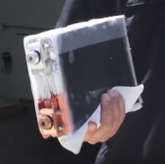Johan
Off-grid energy systems enthusiast.
Here are two teardown videos of prismatic LFP cells. This can (or not?) be useful when accidentally stripping the terminal threads and considering strategies for repair (or not). Feel free to add more, especially for the "blueys".
1) CA180FI (I think - specs).
Screenshot of the aluminium terminal @ 10:25mm:ss

2) Voltronix 160Ah (specs).
Screenshot after opening @ 1:50m:ss

1) CA180FI (I think - specs).
Screenshot of the aluminium terminal @ 10:25mm:ss

2) Voltronix 160Ah (specs).
Screenshot after opening @ 1:50m:ss








